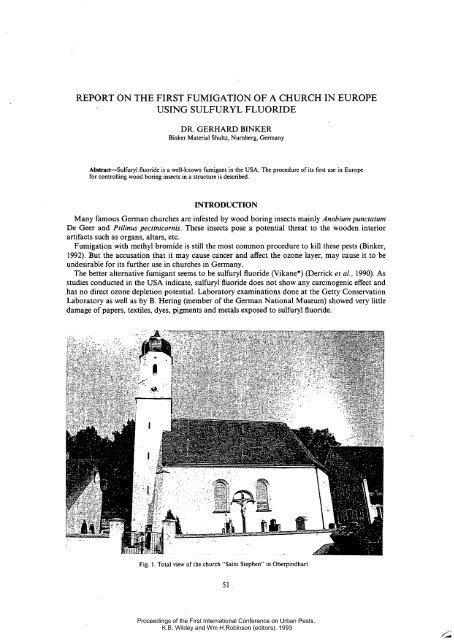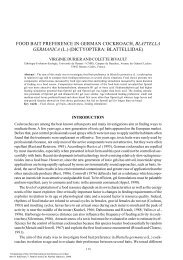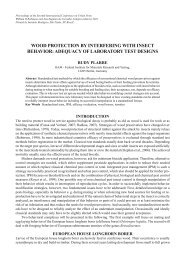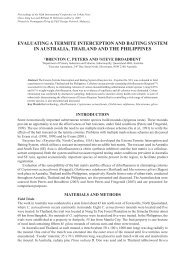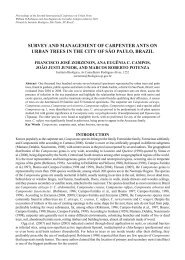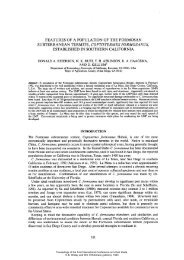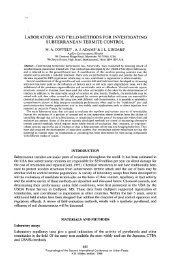report on the first fumigation of a church in europe using sulfuryl ...
report on the first fumigation of a church in europe using sulfuryl ...
report on the first fumigation of a church in europe using sulfuryl ...
Create successful ePaper yourself
Turn your PDF publications into a flip-book with our unique Google optimized e-Paper software.
REPORT ON THE FIRST FUMIGATION OF A CHURCH IN EUROPE<br />
USING SULFURYL FLUORIDE<br />
DR. GERHARD BINKER<br />
B<strong>in</strong>ker Material Shultz, Numberg, Germany<br />
Abstract-Sulfuryl fluoride is a well-known fumigant <strong>in</strong> <strong>the</strong> USA. The procedure <strong>of</strong> its <strong>first</strong> use <strong>in</strong> Europe<br />
for c<strong>on</strong>troll<strong>in</strong>g wood bor<strong>in</strong>g <strong>in</strong>sects <strong>in</strong> a structure is described.<br />
INTRODUCTION<br />
Many famous German <strong>church</strong>es are <strong>in</strong>fested by wood bor<strong>in</strong>g <strong>in</strong>sects ma<strong>in</strong>ly Anobiwn punctatum<br />
De Geer and Ptil<strong>in</strong>us pect<strong>in</strong>icornis. These <strong>in</strong>sects pose a potential threat to <strong>the</strong> wooden <strong>in</strong>terior<br />
artifacts such as organs, altars, etc.<br />
Fumigati<strong>on</strong> with methyl bromide is still <strong>the</strong> most comm<strong>on</strong> procedure to kill <strong>the</strong>se pests (B<strong>in</strong>ker,<br />
1992). But <strong>the</strong> accusati<strong>on</strong> that it may cause cancer and affect <strong>the</strong> oz<strong>on</strong>e layer, may cause it to be<br />
undesirable for its fur<strong>the</strong>r use <strong>in</strong> <strong>church</strong>es <strong>in</strong> Germany.<br />
The better alternative fumigant seems to be <strong>sulfuryl</strong> fluoride (Vikane*) (Demck et al., 1990). As<br />
studies c<strong>on</strong>ducted <strong>in</strong> <strong>the</strong> USA <strong>in</strong>dicate, <strong>sulfuryl</strong> fluoride does not show any carc<strong>in</strong>ogenic effect and<br />
has no direct oz<strong>on</strong>e depleti<strong>on</strong> potential. Laboratory exam<strong>in</strong>ati<strong>on</strong>s d<strong>on</strong>e at <strong>the</strong> Getty C<strong>on</strong>servati<strong>on</strong><br />
Laboratory as well as by B. Her<strong>in</strong>g (member <strong>of</strong> <strong>the</strong> German Nati<strong>on</strong>al Museum) showed very little<br />
damage <strong>of</strong> papers, textiles, dyes, pigments and metals exposed to <strong>sulfuryl</strong> fluoride.<br />
Fig. 1. Total view <strong>of</strong> <strong>the</strong> <strong>church</strong> "Sa<strong>in</strong>t Stephen" <strong>in</strong> Oberp<strong>in</strong>dhart<br />
5 1<br />
Proceed<strong>in</strong>gs <strong>of</strong> <strong>the</strong> First Internati<strong>on</strong>al C<strong>on</strong>ference <strong>on</strong> Urban Pests.<br />
K.B. Wildey and Wm H.Rob<strong>in</strong>s<strong>on</strong> (editors). 1993
52 GERHARD BINKER<br />
Fig. 2. View <strong>of</strong> <strong>the</strong> precious altar<br />
Encouraged by <strong>the</strong>se results, we <strong>in</strong>itiated <strong>the</strong> <strong>first</strong> fumigati<strong>on</strong> us<strong>in</strong>g <strong>sulfuryl</strong> fluoride <strong>of</strong> a structure<br />
<strong>in</strong> Europe. The structure we chose to fumigate is a famous baroque <strong>church</strong>.<br />
This fumigati<strong>on</strong> was camed out <strong>in</strong> October 1992 at <strong>the</strong> <strong>church</strong> "Sa<strong>in</strong>t Stephen" <strong>in</strong> <strong>the</strong> little<br />
Bavarian village <strong>of</strong> Oberp<strong>in</strong>dhart. The whole historical and precious <strong>in</strong>terior was <strong>in</strong>fested by<br />
Anobiidae beetles so a fumigati<strong>on</strong> <strong>of</strong> <strong>the</strong> <strong>church</strong> (exclud<strong>in</strong>g <strong>the</strong> ro<strong>of</strong>) was necessary.<br />
METHODS AND MATERIALS<br />
The <strong>church</strong> was sealed by <strong>the</strong> tape and seal technique. Us<strong>in</strong>g this procedure, all w<strong>in</strong>dows and<br />
doors were covered with poly and all cracks and crevices were sealed with a special adhesive paper.<br />
Proceed<strong>in</strong>gs <strong>of</strong> <strong>the</strong> First Internati<strong>on</strong>al C<strong>on</strong>ference <strong>on</strong> Urban Pests.<br />
K.B. Wildey and Wm H.Rob<strong>in</strong>s<strong>on</strong> (editors). 1993
sem y3!ym 2001 ayl Ou!pnpxa) y3rn1.p ayljo ap!su! ayljo awnIoA ayL .(Ei~ 0001/zo 9f =) Ew/ZdZ~~<br />
8 9c a+% 01 lole1n31e3 ~ v~sds e JO sueaw Lq palelnqe3 svm apu<strong>on</strong>g ~ICrnjIns JO a%esop I~!~Iu! aqL<br />
-wdd 1 JO pIoqsa1ql aql mo~aq LEIS 01<br />
pa~sdxa sem y~~my:, ay1 ap!slno app<strong>on</strong>g pL~nj~ns JO u o ~ ~ e ~ a~ u<br />
.uo!le%pnj ~ u o ~ ay1 Lq palean<br />
aq 01 pavadxa sem pooyloqq91au ayl JOJ u~a~qo~d uo!ss!uIa ou aJojalay1 iC,lq%!1-seZi,, hra~ sem<br />
a~n~~ruls ay1 %u!le3!pu! 'spuoms 9.c SBM auI!1 SsoIjIey pauIuua1ap ayL -pamseaur sem uogqlvllnau<br />
a~nssald puv aw!l sso~ jley ayl pue paddols sem wnn3ea ~ e ~ a= ~ e.y~rnq3<br />
d ay1 ap!slno pallelsu!<br />
UEJ e Lq q~rnq3 ay1 u! palelaua% sem ed 01 L1alew!xoldde JO alnssald MOI e sgl 109 ',,%u!lsa1<br />
alnssald MOI,, Lq pay3ay3 s e uo!1e%!wnj ~ alojaq y3~nq:, ayl JO ssauly%!~ se% pal!nbal aqL<br />
Proceed<strong>in</strong>gs <strong>of</strong> <strong>the</strong> First Internati<strong>on</strong>al C<strong>on</strong>ference <strong>on</strong> Urban Pests.<br />
K.B. Wildey and Wm H.Rob<strong>in</strong>s<strong>on</strong> (editors). 1993
54 GERHARD BINKER<br />
Fig. 4. Releas<strong>in</strong>g <strong>the</strong> <strong>sulfuryl</strong> fluoride from <strong>the</strong> cyl<strong>in</strong>der<br />
not fumigated) was determ<strong>in</strong>ed to be 1000 m3 (ca. 35500 ft3). The temperatures <strong>in</strong>side <strong>the</strong> <strong>church</strong><br />
ranged from 6°C-9.5"C (42.8"F-49.1°F). These low temperatures are <strong>in</strong>dicative <strong>of</strong> very difficult<br />
c<strong>on</strong>diti<strong>on</strong>s for kill<strong>in</strong>g <strong>in</strong>sects, because <strong>of</strong> <strong>the</strong>ir reduced rates <strong>of</strong> respirati<strong>on</strong>. Thus, to determ<strong>in</strong>e <strong>the</strong><br />
effectiveness <strong>of</strong> <strong>the</strong> fumigati<strong>on</strong>, wooden blocks and metal cages with Anobiidae larvae were posted<br />
at various positi<strong>on</strong>s <strong>in</strong> <strong>the</strong> <strong>church</strong>.<br />
The <strong>sulfuryl</strong> fluoride was released from a cyl<strong>in</strong>der outside <strong>the</strong> structure through an applicati<strong>on</strong><br />
hose with a filter to remove impurities from <strong>the</strong> <strong>sulfuryl</strong> fluoride.<br />
The fumigant was directed toward efficient fans, which ensured rapid and uniform distributi<strong>on</strong>.<br />
To avoid damage caused by a "fog-out" <strong>of</strong> <strong>the</strong> gas, it was also important not to exceed <strong>the</strong> shoot<strong>in</strong>g<br />
Proceed<strong>in</strong>gs <strong>of</strong> <strong>the</strong> First Internati<strong>on</strong>al C<strong>on</strong>ference <strong>on</strong> Urban Pests.<br />
K.B. Wildey and Wm H.Rob<strong>in</strong>s<strong>on</strong> (editors). 1993
Report <strong>on</strong> <strong>the</strong> <strong>first</strong> fumigati<strong>on</strong> <strong>of</strong> a <strong>church</strong> <strong>in</strong> Europe us<strong>in</strong>g <strong>sulfuryl</strong> fluoride 55<br />
rate <strong>of</strong> 1 kg S02F2/m<strong>in</strong> (= 2.2 lb/m<strong>in</strong>). After <strong>the</strong> gas shoot<strong>in</strong>g was f<strong>in</strong>ished, <strong>the</strong> <strong>church</strong> was checked<br />
for leaks with an Interscan Gas Analyzer, a m<strong>on</strong>itor<strong>in</strong>g device capable <strong>of</strong> measur<strong>in</strong>g <strong>sulfuryl</strong><br />
fluoride c<strong>on</strong>centrati<strong>on</strong>s between 1 and 50 ppm. No serious leaks were detected as a result <strong>of</strong> <strong>the</strong><br />
careful seal<strong>in</strong>g. Additi<strong>on</strong>ally, each day <strong>the</strong> gas c<strong>on</strong>centrati<strong>on</strong> outside <strong>the</strong> <strong>church</strong> near <strong>the</strong> adjacent<br />
dwell<strong>in</strong>g houses was measured frequently, while <strong>the</strong> actual c<strong>on</strong>centrati<strong>on</strong> with<strong>in</strong> <strong>the</strong> fumigati<strong>on</strong><br />
site was m<strong>on</strong>itored with a Fumiscope, an <strong>in</strong>strument capable <strong>of</strong> measur<strong>in</strong>g <strong>sulfuryl</strong> fluoride<br />
c<strong>on</strong>centrati<strong>on</strong>s <strong>in</strong> oz/1000 ft3.<br />
Evaluati<strong>on</strong> <strong>of</strong> <strong>the</strong> Fumiscope measurements <strong>in</strong>dicated a half loss time for <strong>sulfuryl</strong> fluoride <strong>of</strong> 67 h.<br />
After 162.5 hours <strong>of</strong> exposure, 8 g/m3 (8 oz/1000 ft3) rema<strong>in</strong>ed with<strong>in</strong> <strong>the</strong> <strong>church</strong> for aerati<strong>on</strong>. The<br />
build<strong>in</strong>g was aerated us<strong>in</strong>g fans to enhance ventilati<strong>on</strong>. The <strong>sulfuryl</strong> fluoride c<strong>on</strong>centrati<strong>on</strong> with<strong>in</strong><br />
<strong>the</strong> <strong>church</strong> was decreased to 1 ppm with<strong>in</strong> 4 hours and at that time <strong>the</strong> <strong>church</strong> was ready for re-entry<br />
to remove all <strong>the</strong> seal<strong>in</strong>g materials and equipment.<br />
RESULTS<br />
No test <strong>in</strong>sects survived <strong>the</strong> treatment, which. was checked by <strong>the</strong> BAM, which is <strong>the</strong> Federal<br />
Institute for Test<strong>in</strong>g <strong>of</strong> Materials. Fur<strong>the</strong>rmore, no <strong>in</strong>terior surfaces were damaged. Due to <strong>the</strong><br />
chemical <strong>in</strong>ertness <strong>of</strong> <strong>sulfuryl</strong> fluoride , <strong>the</strong>re was no tarnish<strong>in</strong>g <strong>of</strong> any golden coat<strong>in</strong>gs, coloured<br />
glass or alter<strong>in</strong>g <strong>of</strong> <strong>the</strong> valuable and historical artifacts and ceil<strong>in</strong>g pa<strong>in</strong>t<strong>in</strong>gs.<br />
A sec<strong>on</strong>dary benefit was <strong>the</strong> survival <strong>of</strong> <strong>the</strong> bats <strong>in</strong> <strong>the</strong> untreated <strong>church</strong> l<strong>of</strong>t.<br />
DISCUSSION<br />
Sulfuryl fluoride proved to be an effective structural fumigant. No visible damage was ascerta<strong>in</strong>able.<br />
These results make <strong>sulfuryl</strong> fluoride look promis<strong>in</strong>g for use as an artifact fumigant. S<strong>in</strong>ce<br />
possible reacti<strong>on</strong>s may not produce visible changes, more exam<strong>in</strong>ati<strong>on</strong>s need to be d<strong>on</strong>e <strong>in</strong> future.<br />
ACKNOWLEDGMENTS<br />
The author would like to thank Dr. Ellen Thorns, Chris Jger, Dr. Brian Schneider, Dr. Christoph<br />
Reichmuth and Gerhard Schmidt for support.<br />
REFERENCES<br />
C. B<strong>in</strong>ker (1992). Hilfe fir Maria Hilf. Bausubstanz, 0750-52.<br />
M.R. Derrick, H.D. Burgess, M.T. Baker and N.E. Biie (1990). Sulfuryl fluoride (Vikane): A review <strong>of</strong> its use as a fumigant.<br />
JAIC, 29:77-90.<br />
Proceed<strong>in</strong>gs <strong>of</strong> <strong>the</strong> First Internati<strong>on</strong>al C<strong>on</strong>ference <strong>on</strong> Urban Pests.<br />
K.B. Wildey and Wm H.Rob<strong>in</strong>s<strong>on</strong> (editors). 1993


